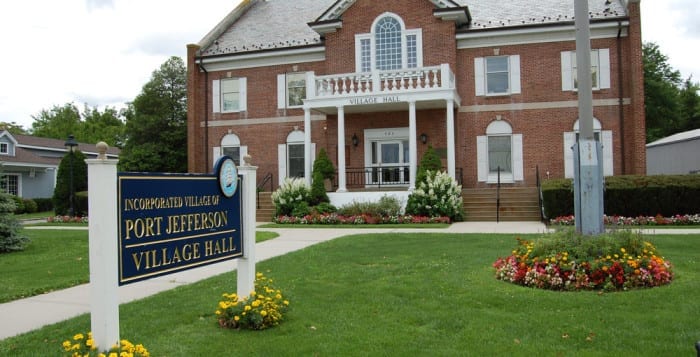It’s been a long and harrowing timeline of events for local officials and residents who use East Beach and the surrounding country club.
For years now, the village has been preparing for this moment, where the tennis courts and Port Jefferson Country Club have seemingly moved to the edge of the cliff overlooking the beach thanks to climate change and the ever-increasing erosion.
To the naked eye, one can see a gazebo in photos hanging by a thread. The tennis courts will be next. Eventually, if nothing is done, the club could potentially collapse into the harbor and have devastating impacts on the local environment. Over the course of several months, Mayor Margot Garant, village administrator Joe Palumbo and the village trustees have been anticipating this moment where something needs to be done now.
“We lost so much material,” Garant said. “The deck is approximately 30 feet from the bluff line … the gazebo isn’t there anymore. We’re getting very, very close to the bluff.”
Because the tennis courts are so close to the edge now, tennis at the country club had to be canceled for this season.

The backstory
In February, a representative from CGI Engineering, Varoujan Hagopian, presented to the board what could happen with three different options on the table: build a wall at the bottom of the bluff; renovate the building and surrounding areas upland; or do nothing at all.
Hagopian said that many clients he works with on the Eastern Seaboard are experiencing the same, or similar issues. “If you do nothing, this kind of erosion will continue,” he said. “I estimate the building will be totally damaged or gone in three to five years. I’m not trying to scare you, but these are realistic calculations.”
Hagopian added that although the building might be gone, that means it will impact the road and East Beach as a whole. The erosion won’t stop at the club.
Two weeks later at the March 3 work session, the board listened in to Garant’s presentation on the bluff, where she gave a detailed history of just how much East Beach has been through over the last decade.
The restoration project began in 2010, with engineering group GEI working on several projects that included the sea wall restoration, the west end wall extension, a ramp installation, a large jetty project and sand dredging, which was finally completed in 2021.
Garant said that the village and its surrounding beaches have seen devastating effects of different storms throughout the years, including Irene, Sandy and more recently, Isaiah back in September.

Finding funding
Meanwhile, Palumbo has been working with the DEC and with FEMA applications to try to get some federal funding — a feat that takes a lot of time and a lot of patience.
The East Beach Bluff Stabilization Phase I project’s DEC permit was originally filed in 2016, finally being awarded in June 2021, with the U.S. Army Corps of Engineers’ approval being obtained in September.
The DEC approved plans call for 454 linear feet of steel wall and rock revetment with tiebacks to stabilize the lower bluff and bolstering the “groin” to prevent further erosion into the roadway, according to a February presentation.
A significant expense of the entire project is the replanting of the entire flank of the hill which includes core logs, erosion control blankets, wood terracing, soil anchors and tens of thousands of native plants, including woody plants, beach and switch grasses.
The comprehensive project and detailed drawings were put out for competitive bidding. Twelve bids came in ranging from $4.8 million to $6.2 million. Funding the project will require a bond initiative, which will have an impact of increasing the typical household tax bill by approximately $147 per annum over the 15-year term if no other sources of funding are available or if no other budgetary changes are made.
The final awarded bid for the lower wall project ended up being $4.3 million. But when it comes to federal funding, the village is competing with other locations which have had their share of issues with Mother Nature.
“We were denied the application for the reimbursement of the bluff, they claimed, in short, that it was an existing condition,” Palumbo said.
“We’re appealing that because we know it’s a preexisting condition and it’s going to be a condition that will continue to occur if our measures aren’t taken to the bluff.”
The village has recently enlisted the assistance of Congressman Lee Zeldin (R-NY1), who is offering his full support to the appeal to FEMA and helping to seek other funding sources.
Palumbo added that he has been in talks with decision makers with FEMA weekly, and has been scouring to find other types of funding that could help offset the cost.
“This is probably one of the most expensive projects any municipality on Long Island has ever had to deal with,” Garant said. “This is a severe erosion issue and it’s not going away. We might lose a lot more than we already have lost if we don’t act quickly.”
For more information, including the plans to stabilize and restore the bluff, visit the website portjeff.com/eastbeachbluff.



































